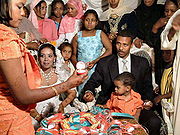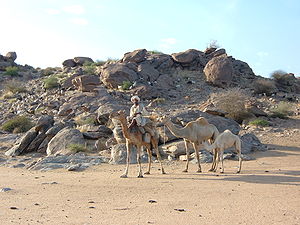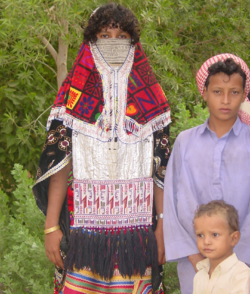
Demography of Sudan
Encyclopedia




Demographics
Demographics are the most recent statistical characteristics of a population. These types of data are used widely in sociology , public policy, and marketing. Commonly examined demographics include gender, race, age, disabilities, mobility, home ownership, employment status, and even location...
features of the population
Population
A population is all the organisms that both belong to the same group or species and live in the same geographical area. The area that is used to define a sexual population is such that inter-breeding is possible between any pair within the area and more probable than cross-breeding with individuals...
of Sudan
Sudan
Sudan , officially the Republic of the Sudan , is a country in North Africa, sometimes considered part of the Middle East politically. It is bordered by Egypt to the north, the Red Sea to the northeast, Eritrea and Ethiopia to the east, South Sudan to the south, the Central African Republic to the...
, including population density
Population density
Population density is a measurement of population per unit area or unit volume. It is frequently applied to living organisms, and particularly to humans...
, ethnicity
Ethnic group
An ethnic group is a group of people whose members identify with each other, through a common heritage, often consisting of a common language, a common culture and/or an ideology that stresses common ancestry or endogamy...
, education level, health of the populous, economic status, religious affiliations and other aspects of the population.
In Sudan
Sudan
Sudan , officially the Republic of the Sudan , is a country in North Africa, sometimes considered part of the Middle East politically. It is bordered by Egypt to the north, the Red Sea to the northeast, Eritrea and Ethiopia to the east, South Sudan to the south, the Central African Republic to the...
's 1993 census, the population was calculated at 25 million. No comprehensive census has been carried out since that time due to the civil war. Estimates of Sudan, including the population of South Sudan
South Sudan
South Sudan , officially the Republic of South Sudan, is a landlocked country located in the Sahel region of northeastern Africa. It is also part of the North Africa UN sub-region. Its current capital is Juba, which is also its largest city; the capital city is planned to be moved to the more...
, ranged from 37 million (United Nations estimate) to 45 million (CIA estimate). Since the secession of South Sudan
South Sudan
South Sudan , officially the Republic of South Sudan, is a landlocked country located in the Sahel region of northeastern Africa. It is also part of the North Africa UN sub-region. Its current capital is Juba, which is also its largest city; the capital city is planned to be moved to the more...
in July 2011, estimates place the current population of Sudan at a little over 30 million.
The population of metropolitan Khartoum
Khartoum
Khartoum is the capital and largest city of Sudan and of Khartoum State. It is located at the confluence of the White Nile flowing north from Lake Victoria, and the Blue Nile flowing west from Ethiopia. The location where the two Niles meet is known as "al-Mogran"...
(including Khartoum, Omdurman
Omdurman
Omdurman is the second largest city in Sudan and Khartoum State, lying on the western banks of the River Nile, opposite the capital, Khartoum. Omdurman has a population of 2,395,159 and is the national centre of commerce...
, and Khartoum North) is growing rapidly and ranges from six to seven million, including around two million displaced persons from the southern war zone as well as western and eastern drought-affected areas.
Despite a predominate Arab culture and identity, Sudan has hundreds of ethnic and tribal divisions and language groups between them, which makes effective collaboration among them a major problem.
Population Overview
Most Sudanese are ArabicArabic language
Arabic is a name applied to the descendants of the Classical Arabic language of the 6th century AD, used most prominently in the Quran, the Islamic Holy Book...
-speaking Muslim
Muslim
A Muslim, also spelled Moslem, is an adherent of Islam, a monotheistic, Abrahamic religion based on the Quran, which Muslims consider the verbatim word of God as revealed to prophet Muhammad. "Muslim" is the Arabic term for "submitter" .Muslims believe that God is one and incomparable...
s, though the majority also use a traditional non-Arabic mother tongue (i.e., Nubian
Nubian languages
The Nubian language group, according to the most recent research by Bechhaus-Gerst comprises the following varieties:# Nobiin ....
, Beja
Beja language
Beja or North Cushitic is an Afro-Asiatic language of the southern coast of the Red Sea, spoken by about two million nomads, the Beja, in parts of Egypt, Sudan, and Eritrea.-Classification:...
, Fur
Fur language
All sounds are spelt with their IPA symbols except for the following: j = , ñ = and y = . Arabic consonants are sometimes used in loanwords.The vowels are as in Latin: a e i o u...
, Nuba
Nuba
Nuba is a collective term used here for the peoples who inhabit the Nuba Mountains, in Sudan, Africa. Although the term is used to describe them as if they composed a single group, the Nuba are multiple distinct peoples and speak different languages...
, Ingessana
Ingessana
Ingessana are the members of an ethnic group of Sudan. They live around the Tabi Hills, between the Blue and White Niles and speak the Gaam language....
, etc.). Among these are several distinct tribal groups; the Kababish
Kababish
The Kababish are a Sunni Muslim nomadic camel-raising tribe of the northern Kordofan region of Sudan.The Kababish are a loose tribal confederation of Arabic people of mixed origins, numbering about 70,000, who live in a region of desert scrubland....
of northern Kordofan, a camel-raising people; the Ja'Alin
Ja'Alin
Ja'alin are an Arab, Semitic tribe. They formerly occupied the country on both banks of the Nile from Khartoum to Abu Hamad. They trace their lineage to Abbas, uncle of the Islamic prophet Muhammad. They are of Arab origin, but now of mixed blood mostly with upper Egyptians and nubians. They...
and Shaigiyya groups of settled tribes along the rivers; the seminomadic Baggara of Kordofan and Darfur; the Beja in the Red Sea area and Nubians of the northern Nile areas, some of whom have been resettled on the Atbara River; and the Nuba of southern Kordofan and Fur
Fur people
The Fur are an ethnic group from western Sudan, principally inhabiting the region of Darfur where they are the largest tribe....
in the western reaches of the country.
Population Statistics
Achieving good counts of the population is difficult in Sudan, because conducting a censusCensus
A census is the procedure of systematically acquiring and recording information about the members of a given population. It is a regularly occurring and official count of a particular population. The term is used mostly in connection with national population and housing censuses; other common...
has been difficult due to various conflicts and wars in the southern, eastern and western regions of Sudan over the past few decades. The government of South Sudan
South Sudan
South Sudan , officially the Republic of South Sudan, is a landlocked country located in the Sahel region of northeastern Africa. It is also part of the North Africa UN sub-region. Its current capital is Juba, which is also its largest city; the capital city is planned to be moved to the more...
(led by the former SPLM resistance movement) has in the past accused Sudan of deliberately manipulating the census in oil-rich regions such as the Abyei
Abyei
The Abyei Area is an area of in Sudan accorded "special administrative status" by the 2004 Protocol on the resolution of the Abyei conflict in the Comprehensive Peace Agreement that ended the Second Sudanese Civil War. The capital of Abyei Area is Abyei Town...
district, on the border between Sudan and South Sudan
South Sudan
South Sudan , officially the Republic of South Sudan, is a landlocked country located in the Sahel region of northeastern Africa. It is also part of the North Africa UN sub-region. Its current capital is Juba, which is also its largest city; the capital city is planned to be moved to the more...
. The population count is a determining factor for the share of wealth and power each part of Sudan receives after the secession of South Sudan
South Sudan
South Sudan , officially the Republic of South Sudan, is a landlocked country located in the Sahel region of northeastern Africa. It is also part of the North Africa UN sub-region. Its current capital is Juba, which is also its largest city; the capital city is planned to be moved to the more...
(See: Naivasha Agreement). Another complication is the Southern Sudanese refugees present in the north, whose citizenship in Sudan
Sudan
Sudan , officially the Republic of the Sudan , is a country in North Africa, sometimes considered part of the Middle East politically. It is bordered by Egypt to the north, the Red Sea to the northeast, Eritrea and Ethiopia to the east, South Sudan to the south, the Central African Republic to the...
after the secession of South Sudan
South Sudan
South Sudan , officially the Republic of South Sudan, is a landlocked country located in the Sahel region of northeastern Africa. It is also part of the North Africa UN sub-region. Its current capital is Juba, which is also its largest city; the capital city is planned to be moved to the more...
is now in question.
CIA World Factbook demographic statistics
The following demographic statistics are from the CIA World Factbook, unless otherwise indicated. These statistics do not take into account the recent secession of South SudanSouth Sudan
South Sudan , officially the Republic of South Sudan, is a landlocked country located in the Sahel region of northeastern Africa. It is also part of the North Africa UN sub-region. Its current capital is Juba, which is also its largest city; the capital city is planned to be moved to the more...
in July 2011 unless otherwise indicated, which would significantly reduce the population totals and affect other figures as well.
Population
45,047,502 (July 2011 est.; does not take into account the secession of South SudanSouth Sudan
South Sudan , officially the Republic of South Sudan, is a landlocked country located in the Sahel region of northeastern Africa. It is also part of the North Africa UN sub-region. Its current capital is Juba, which is also its largest city; the capital city is planned to be moved to the more...
)
Age structure
0–14 years:
42.1% (male 9,696,726; female 9,286,894)
15–64 years:
55.2% (male 12,282,082; female 12,571,424)
65 years and over:
2.7% (male 613,817; female 596,559) (2011 est.; does not take into account the secession of South Sudan
South Sudan
South Sudan , officially the Republic of South Sudan, is a landlocked country located in the Sahel region of northeastern Africa. It is also part of the North Africa UN sub-region. Its current capital is Juba, which is also its largest city; the capital city is planned to be moved to the more...
)
Sex ratio
at birth:
1.05 male(s)/female
under 15 years:
1.04 male(s)/female
15–64 years:
1.01 male(s)/female
65 years and over:
1.05 male(s)/female
total population:
1.03 male(s)/female (2011 est.)
Infant mortality rate
Total population: 68.07 deaths/1,000 live birthsMale: 68.77 deaths/1,000 live births
Female: 67.34 deaths/1,000 live births (2011 est.)
Life expectancy at birth
total population:55.42 years
male:
54.18 years
female:
56.71 years (2011 est.)
Total fertility rate
- 4.93 children born/woman (2010 est.)
- 5.47 children born/woman (2000 est.)
Ethnic groups
blackBlack people
The term black people is used in systems of racial classification for humans of a dark skinned phenotype, relative to other racial groups.Different societies apply different criteria regarding who is classified as "black", and often social variables such as class, socio-economic status also plays a...
52% (rubric that includes numerous ethnic groups), Arab
Arab
Arab people, also known as Arabs , are a panethnicity primarily living in the Arab world, which is located in Western Asia and North Africa. They are identified as such on one or more of genealogical, linguistic, or cultural grounds, with tribal affiliations, and intra-tribal relationships playing...
39%, Beja
Beja people
The Beja people are an ethnic group dwelling in parts of North Africa and the Horn of Africa.-Geography:The Beja are found mostly in Sudan, but also in parts of Eritrea, and Egypt...
6%, foreigners 2%, other 1%
Religions
Sunni Muslim 97 percent (estimate after the secession of South SudanSouth Sudan
South Sudan , officially the Republic of South Sudan, is a landlocked country located in the Sahel region of northeastern Africa. It is also part of the North Africa UN sub-region. Its current capital is Juba, which is also its largest city; the capital city is planned to be moved to the more...
). Animist traditional beliefs and Christianity make up the remaining 3 percent.
Languages
ArabicArabic language
Arabic is a name applied to the descendants of the Classical Arabic language of the 6th century AD, used most prominently in the Quran, the Islamic Holy Book...
(official), English
English language
English is a West Germanic language that arose in the Anglo-Saxon kingdoms of England and spread into what was to become south-east Scotland under the influence of the Anglian medieval kingdom of Northumbria...
(official), Nubian, Ta Bedawie
Beja language
Beja or North Cushitic is an Afro-Asiatic language of the southern coast of the Red Sea, spoken by about two million nomads, the Beja, in parts of Egypt, Sudan, and Eritrea.-Classification:...
Literacy
definition:
age 15 and over can read and write
total population:
61.1%
male:
71.8%
female:
50.5% (2003 est.)

